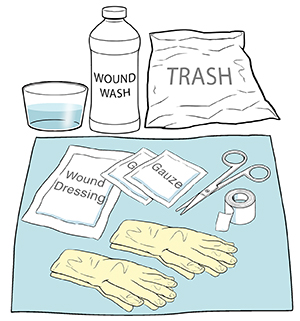Incision Care: Abdomen
Dressing your incision helps keep it clean, dry, and infection-free. That way, it will heal faster. Follow the steps below, whether dressing the incision yourself or with the help of a family member or other caregiver.

Step 1. Wash your hands and set up
-
Use liquid soap. Lather and scrub vigorously for at least 20 seconds. Scrub between your fingers and under your nails.
-
Rinse with clean, running water, keeping fingers pointing down. Use a clean paper towel to dry your hands and turn off the faucet.
-
It's also acceptable to clean your hands with an alcohol-based hand sanitizer that contains at least 60% alcohol if soap and water are not available.
-
Put all your supplies on a clean cloth or paper towel. Open a plastic trash bag.
-
Peel back the edges of the dressing packages. Pour any irrigation solutions into solution cups.
-
Clean the scissors with soap and water. Cut each piece of tape 4 inches longer than the dressing.
Step 2. Remove the old dressing
-
Put on new disposable medical gloves.
-
Loosen the tape by pulling gently toward the incision. Remove the dressing one layer at a time. Put it right into the plastic bag.
-
Remove your gloves and put them in the plastic bag. Wash your hands again, as described above. Then put on new gloves.
Step 3. Clean and dress the incision
-
Clean the incision and apply a new dressing as directed.
-
Put all used supplies in the plastic bag.
-
Remove your gloves last and put them in the bag.
-
Seal the bag and put it in the trash.
-
Be sure to wash your hands again.
When to call your healthcare provider
Call your healthcare provider if any of these happen:
-
Your incision suddenly opens
-
You have bleeding from the incision, or an increase in its size
-
Increased redness, swelling, or drainage
-
Pain in or around the incision
-
Change in the color of the incision
-
Fever of 100.4°F ( 38°C ) or higher, or as directed by your healthcare provider
-
Chills
Online Medical Reviewer:
Jonas DeMuro MD
Online Medical Reviewer:
Raymond Turley Jr PA-C
Online Medical Reviewer:
Tara Novick BSN MSN
Date Last Reviewed:
3/1/2022
© 2000-2024 The StayWell Company, LLC. All rights reserved. This information is not intended as a substitute for professional medical care. Always follow your healthcare professional's instructions.